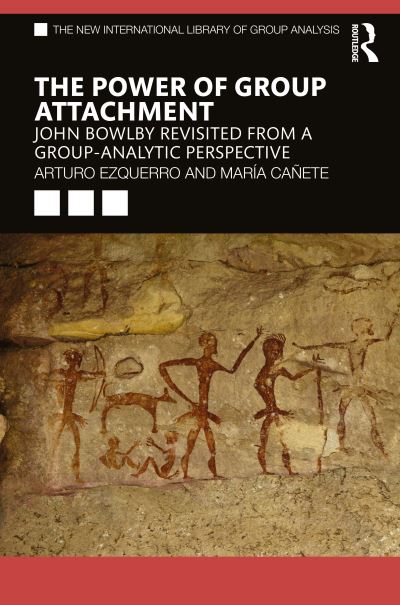The Power of Group Attachment: John Bowlby Revisited from a Group-Analytic Perspective

Book Details
- Publisher : Routledge
- Published : 2024
- Cover : Paperback
- Pages : 290
- Category :
Group Psychotherapy - Catalogue No : 97763
- ISBN 13 : 9781032222943
- ISBN 10 : 1032222948
Table of Contents
Endorsements
About the authors
Dedication
Acknowledgments
Preface by Sir Paul Preston
Foreword by Dr Earl Hopper
Introduction: A radical group attachment viewpoint
Arturo Ezquerro and María Cañete
- The interface between interpersonal and group attachment
- Synopses of the book chapters
- Some learning points and concluding thoughts
1. Group attachment created humankind
Arturo Ezquerro and María Cañete
1.1. Introduction
1.1.(i) Contents and aims of the chapter
1.2. Section I: An exploration through human evolution
1.2.(i) The birth of humankind
1.2.(ii) The growth of the human group
1.2.(iii) Migratory processes: survival and exploration
1.2.(iv) The need for group attachment
1.2.(v) Does stranger mean danger?
1.2.(vi) Alloparenting and group attachment
1.2.(vii) The cultural acquisition device
1.2.(viii) Monotropic versus multiple caregiving
1.2.(ix) Further thoughts on group attachment
1.2.(x) Group selection and natural selection
1.3. Section II: Group attachment as an evolving concept
1.3.(i) An implicit sense of group attachment
1.3.(ii) Systematic research on group attachment
1.3.(iii) Attachment and group analysis
1.3.(iv) Attachment and wider group psychotherapy
1.3.(v) Organisations as a group-attachment space
1.3.(vi) Conceptualising group attachment
1.4. Conclusion
2. Bipolar disorder: ups and downs affecting interpersonal and group life
Arturo Ezquerro and María Cañete
2.1. Introduction: The worst disaster that can befall a group?
2.1.(i) Contents and aims of the chapter
2.2. Historical context: From the Old Testament through the Classics to the Mystics
2.2.(i) Melancholia and mania in the Early Modern period and Industrial Age
2.3. Contemporary psychiatric perspectives
2.3.(i) The impact of lithium on the management of manic-depressive psychosis
2.3.(ii) Early 21st century: Bipolar times
2.4. Psychoanalytic and attachment contributions
2.5. Review of the literature on group psychotherapy with bipolar patients
2.6. A clinical case study by Arturo Ezquerro
2.6.(i) The referral and assessment process
2.6.(ii) A newcomer in an ongoing psychotherapy group
2.6.(iii) Protecting personal and group boundaries
2.6.(iv) Group cohesion versus group coherency
2.7. Discussion
2.8. Conclusion
3. Fostering a group attachment culture in a day-unit for psychotic patients
Arturo Ezquerro and María Cañete
3.1. Introduction
3.1.(i) Contents and aims of the chapter
3.2. Traditional psychoanalytic perspectives on psychosis
3.3. Bowlby’s attachment response to Freudian formulations
3.4. Other psychoanalytic contributions
3.5. Contemporary attachment standpoints on psychosis
3.6. An outline of the literature on group psychotherapy for psychosis
3.7. A case study by María Cañete: Group-analytic therapy with psychotic patients
3.7.(i) The small therapy group: early stages
3.7.(ii) Laughter: defence or enriching reinforcement?
3.7.(iii) Developing a therapeutic culture within the group matrix
3.7.(iv) Endings and new beginnings
3.8. Discussion
3.9. Conclusion
4. Suicide risk: when group attachment is not enough, or is it?
Arturo Ezquerro
4.1. Introduction: Individual or group psychotherapy for suicidal patients?
4.1.(i) Contents and aims of the chapter
4.2. Combining individual and group psychotherapy for highly vulnerable patients
4.3. Suicide from an attachment perspective
4.4. Further thoughts on suicidality
4.4.(i) An evolutionary perspective
4.4.(ii) Approaching suicide risk we an ethos of “we are all in the same boat”
4.4.(iii) Some recent developments on suicide prevention
4.5. The clinical picture
4.6. The therapy group
4.7. Individual and group psychotherapy combined
4.8. Discussion
4.9. Conclusion
5. Group cohesion versus group coherency through an attachment lens
Arturo Ezquerro
5.1. Introduction: The politics of uncertainty
5.1.(i) Contents and aims of the chapter
5.2. Complexity, cohesion and coherency in group psychotherapy
5.3. An attachment perspective on group cohesion and group coherency
5.4. A clinical case study
5.4.(i) Interpersonal and group ruptures
5.4.(ii) Reparative group work: from cohesion to coherency
5.5. Discussion
5.6. Conclusion
6. A case of perverse group attachment
Arturo Ezquerro
6.1. Introduction
6.1.(i) Contents and aims of the chapter
6.2. Filicide: an overview
6.3. Captain Aguilera: the man
6.3.(i) Going back to an insecure base
6.3.(ii) A military coup leading to a civil war
6.3.(iii) The aftermath of a devastating war
6.3.(iv) The captain’s late years resulting in tragedy
6.4. A group culture of unresolved trauma, scapegoating and violence
6.4.(i) Vicious repression, racism and genocide
6.4.(ii) The terror guns and voices of a perverse group
6.5. An attachment-based psychodynamic and group-analytic formulation
6.5.(i) Some dynamics of perverse group attachment
6.6. Conclusion
Afterword by Dr Cheri Marmarosh
Index

